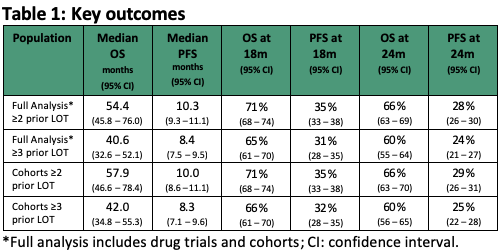
Contributions
Abstract: PB1571
Type: Publication Only
Session title: Indolent and mantle-cell non-Hodgkin lymphoma - Clinical
Background
Patients with follicular lymphoma (FL) can have high response rates to early lines of treatment. However, among FL patients relapsed/refractory (r/r) after ≥2 prior lines of therapies (LOT), remission tends to be shorter. Moreover, there is limited guidance for treatment options among these patients.
Aims
This study sought to evaluate the clinical outcomes for r/r FL after ≥2 prior LOT using currently available treatment options.
Methods
Electronic databases were searched on 2nd June 2020. Eligible studies were comparative or non-comparative interventional or observational studies of systemic therapies among adults with FL r/r after ≥2 prior LOT. Prior LOT must have included anti-CD20 monoclonal antibodies and alkylating agents, in combination or separately. Overall response rate (ORR) and complete response (CR) were analyzed using inverse-variance weighting with Freeman-Tukey double-arcsine transformations. Kaplan-Meier (KM) analysis for progression-free survival (PFS) and overall survival (OS) were conducted using data from digitized curves and prepared using the Guyot algorithm. Survival analyses were stratified by ≥2 prior LOT and ≥3 prior LOT groups and were restricted to the observational cohorts as a sensitivity analysis.
Results
The meta-analysis included 12 studies published from 2014-2020, including three studies that were cohorts using mixed treatments representing currently available treatments. Sample size for response outcomes was 340, for survival outcomes with ≥2 prior LOT was 1024 and for ≥3 prior LOT was 502. The estimated ORR in the ≥2 prior LOT group was 56.0% (95% confidence interval [CI]: 47.2 – 64.5) and proportion of patients with CR was 12.2% (95% CI: 8.0 – 17.3). The median OS was 54.4 months (95% CI: 45.8 – 76.0) and median PFS was 10.3 months (95% CI: 9.3 – 11.1). The 24-month OS decreased from 66% in the ≥2 prior LOT group to 60% in the ≥3 prior LOT group (Table 1), with a similar trend in PFS at 24-month (28% vs 24%).

Conclusion
This study found that few r/r FL patients with ≥2 prior LOT achieve CR, and despite some benefit, approximately 1/3 of patients die within 24 months. The shorter median PFS with increasing prior LOT suggest treatment durability is suboptimal in later LOT. These findings indicate that patients are underserved by current treatments, demonstrating a need for new treatments that can achieve high rates of response that are durable in this disease.
Keyword(s): Follicular lymphoma, Indolent non-Hodgkin's lymphoma
Abstract: PB1571
Type: Publication Only
Session title: Indolent and mantle-cell non-Hodgkin lymphoma - Clinical
Background
Patients with follicular lymphoma (FL) can have high response rates to early lines of treatment. However, among FL patients relapsed/refractory (r/r) after ≥2 prior lines of therapies (LOT), remission tends to be shorter. Moreover, there is limited guidance for treatment options among these patients.
Aims
This study sought to evaluate the clinical outcomes for r/r FL after ≥2 prior LOT using currently available treatment options.
Methods
Electronic databases were searched on 2nd June 2020. Eligible studies were comparative or non-comparative interventional or observational studies of systemic therapies among adults with FL r/r after ≥2 prior LOT. Prior LOT must have included anti-CD20 monoclonal antibodies and alkylating agents, in combination or separately. Overall response rate (ORR) and complete response (CR) were analyzed using inverse-variance weighting with Freeman-Tukey double-arcsine transformations. Kaplan-Meier (KM) analysis for progression-free survival (PFS) and overall survival (OS) were conducted using data from digitized curves and prepared using the Guyot algorithm. Survival analyses were stratified by ≥2 prior LOT and ≥3 prior LOT groups and were restricted to the observational cohorts as a sensitivity analysis.
Results
The meta-analysis included 12 studies published from 2014-2020, including three studies that were cohorts using mixed treatments representing currently available treatments. Sample size for response outcomes was 340, for survival outcomes with ≥2 prior LOT was 1024 and for ≥3 prior LOT was 502. The estimated ORR in the ≥2 prior LOT group was 56.0% (95% confidence interval [CI]: 47.2 – 64.5) and proportion of patients with CR was 12.2% (95% CI: 8.0 – 17.3). The median OS was 54.4 months (95% CI: 45.8 – 76.0) and median PFS was 10.3 months (95% CI: 9.3 – 11.1). The 24-month OS decreased from 66% in the ≥2 prior LOT group to 60% in the ≥3 prior LOT group (Table 1), with a similar trend in PFS at 24-month (28% vs 24%).

Conclusion
This study found that few r/r FL patients with ≥2 prior LOT achieve CR, and despite some benefit, approximately 1/3 of patients die within 24 months. The shorter median PFS with increasing prior LOT suggest treatment durability is suboptimal in later LOT. These findings indicate that patients are underserved by current treatments, demonstrating a need for new treatments that can achieve high rates of response that are durable in this disease.
Keyword(s): Follicular lymphoma, Indolent non-Hodgkin's lymphoma


